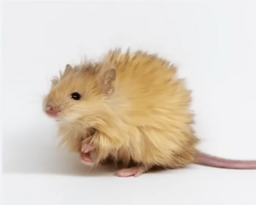Woolly mouse facts for kids
Quick facts for kids Woolly mouse |
|
|---|---|
 |
|
| Organism | Mus musculus |
| Mode | Genome editing |
| Developer | Colossal Biosciences |
| Trait(s) conferred |
|
The woolly mouse is a special kind of lab mouse. It was created in 2024 by a company called Colossal Biosciences. These mice are genetically modified, which means their genes have been changed. They were made to help bring back the woolly mammoth. The woolly mouse has traits like a woolly coat and other changes that help it handle cold weather.
Contents
Why Create the Woolly Mouse?
Colossal Biosciences, an American biotechnology company, started the woolly mouse project. It's part of their bigger plan to bring back the woolly mammoth. The company wants to create animals that look and act like mammoths. They plan to do this by changing the genes of Asian elephants. These new elephants would have traits that help them live in cold places.
How Mammoths Might Help the Planet
The company believes that herds of these new, mammoth-like elephants could help fight climate change. They think these animals could change the Arctic environment. For example, they might graze in ways that help grasslands grow in tundra regions. This could also slow down the melting of permafrost, which is frozen ground. If permafrost melts, it releases carbon dioxide, a gas that warms the planet. So, fewer melting permafrost areas mean less carbon dioxide in the air.
The research was announced on March 4, 2025. At that time, the company said they aimed to have the first elephant calf with mammoth traits by the end of 2028.
How the Woolly Mouse Was Made
Scientists used special methods called genome editing to create the woolly mouse. This means they changed the mouse's DNA. They used two main ways to do this:
- They directly changed the genes in fertilized mouse eggs.
- They changed mouse stem cells, then put these cells into mouse embryos.
After these changes, the modified embryos were placed into surrogate (or "foster") mother mice.
Changing Genes for Special Traits
The research team focused on nine specific genes. These genes control things like hair color, texture, length, and how hair grows. Seven of these genes were chosen because scientists already knew they affected mouse coats. The goal was to make the mice look like mammoths, with golden-colored fur.
For example, they changed the FGF5 gene, which helps control hair growth. They also changed the MC1R gene, which affects how much melanin (a pigment) is made. Two of the genes they changed were similar to genes found in mammoths. These mammoth genes are thought to be why mammoths had woolly coats.
The team also changed a gene linked to how mice use fat. This gene is also found in mammoths. Scientists thought changing it might help the mice handle cold better.
What Happened Next
Many of the changed embryos did not grow into live pups. However, all the mice that were successfully born were still alive as of March 2025. These mice had woolly coats with long hair, about 5 centimeters (2 inches) long. Their fur was a golden-brown color.
The gene editing worked very well in many mice. Some mice had 100% of the planned gene changes. Interestingly, mice with the changed fat metabolism gene did not weigh much differently from other mice. As of the announcement, the team had not yet tested how well the modified mice could handle cold. However, they planned to do these tests soon.
See also
- Colossal Biosciences
- De-extinction
- Revival of the woolly mammoth

